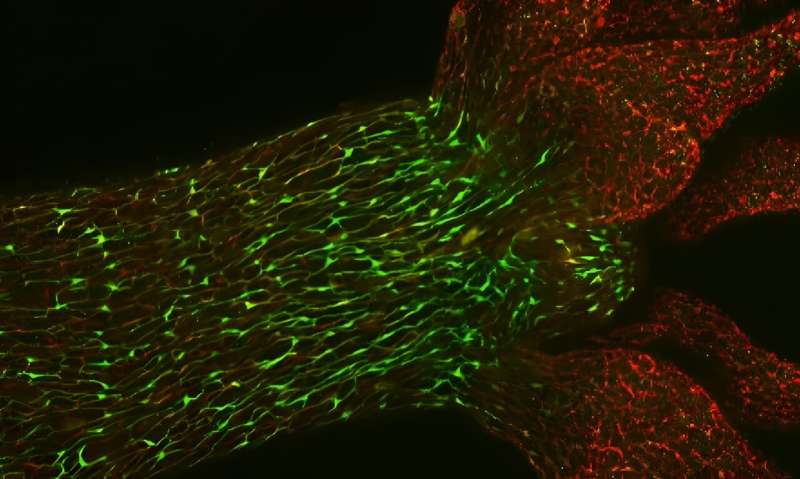This article has been reviewed according to Science X's editorial process and policies. Editors have highlighted the following attributes while ensuring the content's credibility:
fact-checked
peer-reviewed publication
trusted source
proofread
Scientists observe neuronal stimulus transmission by coloring nerve cells with novel antibody

Due to their simple body structure with a limited number of cell types, freshwater polyps (Hydra) can be used to study many fundamental processes of life. In recent years, Hydra has also experienced a renaissance as a model organism for neuroscience—thanks to the US BRAIN initiative.
"Hydra have a very simple nervous system without central control, so they have no brain. The quite complex behavior of the polyp is controlled by a nerve network," explains Hydra expert Prof. Bert Hobmayer from the Institute of Zoology. "What is also exciting about the Hydra's nervous system is that, like Hydra, it is constantly growing. However, it is not yet understood how the new nerve cells that are produced every day are integrated into the existing system."
A new study recently published in the journal eLife under the leadership of the LMU Munich provides news on this topic. Although the nerves in Hydra are connected via neurites, as in more highly developed animals, the nerve impulses are not transmitted directly from neurite tip to neurite tip, but rather neurites from different nerve cells are placed side by side and form bundles.
"The bundles consist of two to seven neurites, and information is transmitted along the entire length of the bundle," says Hobmayer, highlighting a result that particularly surprised the researchers.
The combination of high-resolution electron microscopy and new molecular biological methods also showed that communication in the nervous system mainly takes place via cell–cell connections called gap junctions.
This special structure allows stimuli to propagate at relatively high speed across the entire nervous system and control the behavior of the polyp. The researchers were also able to show that Hydra has two independent nerve networks.
Antibody with a history
These and other detailed observations were made possible by an antibody that was discovered more than 20 years ago in a research project that Hobmayer was involved in at LMU Munich. "We produced the antibody for a different purpose, namely to localize cadherin. It was unsuitable for this, but at the time it was already described as staining the nervous system," says the scientist.
It was precisely this antibody that was used for the recently published study, which was carried out under the supervision of Charles David, Hobmayer's former doctoral supervisor. The contact between mentor and mentee has been maintained for decades, resulting in an old new collaboration.
The zoologists from the University of Innsbruck supported the study primarily through their methodological expertise in working with Hydra. "Looking at processes of cell communication in living organisms requires very individual and good preparation of the animal tissue," says Hobmayer.
"This is the only way we can study each individual tissue with the best possible resolution in the electron microscope." The researchers combined the data from the transmission electron microscope with molecular data and thus obtained a much better picture of how stimulus propagation occurs in this evolutionarily very original nervous system.
Relics of evolution
But understanding the nervous system of the Hydra means even more for science: Namely, gaining a comparative insight into the evolution of multicellular animals and their nervous systems.
Hydra are cnidarians that are more than 600 million years old. Only sponges and comb jellies are even older; both are considered possible starting points for multicellular animals and have different precursors of nervous systems, both of which differ from those of Hydra.
"You can see from these different groups how evolution has experimented," says Hobmayer, referring in this context to recent research that estimates the comb jellyfish, which belongs with Hydra to Coelenterata, as the ancestors of all multicellular animals.
More information: Athina Keramidioti et al, A new look at the architecture and dynamics of the Hydra nerve net, eLife (2024). DOI: 10.7554/eLife.87330.2
Journal information: eLife
Provided by University of Innsbruck



















